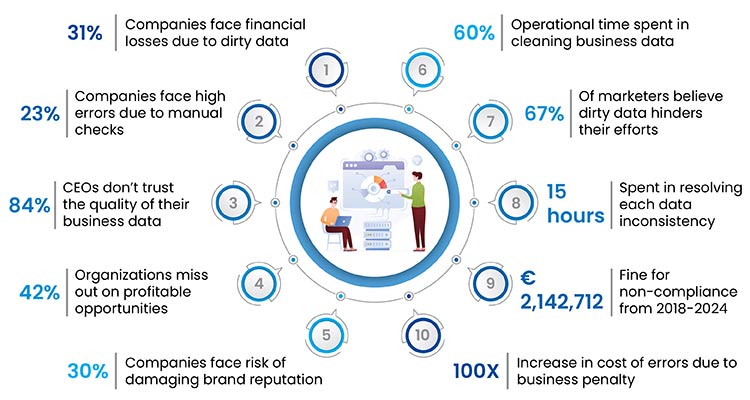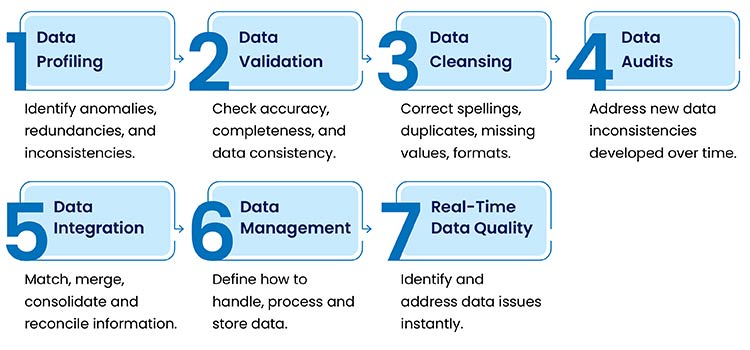Duplicate records, inconsistent data formats, outdated information, and user complaints about data reliability are all data quality red flags that call for immediate data cleansing. Addressing these issues promptly can enhance data integrity and improve business insights.
With dirty data annually costing $12.9 million to organizations, the stakes in ensuring data quality have never been higher. Your business data drives decision-making, marketing strategies, and much more. This makes it important for you to manage and maintain its accuracy and reliability.
However, as data volumes swell, and become more complex and diverse, maintaining perfect data quality becomes a herculean task. That’s exactly where data cleansing comes into play.
Data cleaning, the process of detecting and correcting or removing corrupt or inaccurate records from a dataset, is vital for maintaining the integrity of data. It not only safeguards against costly mistakes but also enhances operational efficiency, ensuring that companies can fully leverage their data assets for strategic advantage.
The presence of dirty data can be marked during data operations. Its presence may also be flagged by other operations like frequently wrong marketing leads. At least 84% of organizations experience data quality challenges during operation phase. But, when errors and duplicate data goes unnoticed, it results in incorrect data analysis and compliance risks.
Contents
10 consequences of bad data on your business

5 signs your data needs a deep clean
Now let’s check out the 5 signs that indicate that your business data needs immediate deep data cleaning.
1. High levels of inaccuracies and errors in data
Typos, incorrect entries, and outdated information are some of the inaccuracies that show up frequently, severely undermining your business’s operational efficiency and decision-making capabilities. These inaccuracies can manifest in various forms, from simple misspellings to the use of obsolete data, each carrying the potential to skew insights and lead to misguided strategies.
Several instances showcase the tangible impacts of data inaccuracies. A simple data entry error at Samsung Securities led to a $300 million loss due to an incorrect dividend payout. In a similar incident Unity Technologies faced a $110 million revenue loss due to inaccuracies in advertising targeting data, significantly affecting its market position. These instances highlight the dire need for you to prioritize data cleansing to mitigate financial losses and operational inefficiencies.
2. Frequent data duplication
Escalated data storage costs and complexities in managing the database are due to frequent data duplication issues that have existed for ages. This data hygiene issue inflates operational expenses, strains resources, muddies the water for data-driven decision-making and further complicates the integrity and analysis of data.
Studies have proved that an alarming 10-30% of an average database is cluttered with duplicate entries. Frequent data duplication leads to redundant communications and misallocated resources, particularly for the sales and marketing domain.
Moreover, analytics derived from such polluted datasets are inherently skewed, misleading marketing strategies, and obscuring genuine customer insights. This underscores the critical need for rigorous data cleansing practices to streamline operations and sharpen the accuracy of business insights.
3. Difficulty in segmenting and analyzing data
Dirty data, characterized by inaccuracies, duplications, and outdated information makes it even more challenging to segment and analyze data to be further used to derive actionable insights and make informed decisions.
And this is not a small complexity. CrowdFlower survey suggests that data scientists cry foul of spending 60% of their time cleaning and organizing data before it can even be analyzed.
Clean data is foundational for advanced analytics and AI applications, enabling more accurate predictions and insights. In a classic market segmentation for boating enthusiasts case study by INSEAD, they demonstrated the iterative process of data preparation, exploration, and analysis critical to achieve meaningful segmentation. In absence of clean data, or without improving the data quality the segmentation solution would have yielded incorrect results and proved significantly less effective.
4. Low engagement rates from marketing campaigns
Marketing campaigns like email marketing, direct mail, or targeted advertising that yield low engagement rates are more than often the result of poor data quality. Inaccurate, outdated, or duplicate data entries hinder your efforts to reach the intended audience, resulting in missed opportunities and wasted resources.
Clean and accurate data, on the other hand, is a game-changer. Companies that have embraced data cleansing practices have witnessed remarkable improvements in their campaign performance. It enhances engagement rates and the overall ROI of marketing efforts. Direct Marketing Association highlights that clean data could boost ROI by up to 66%, showcasing the positive impact of high-quality data on marketing success.
5. Compliance issues and legal risks
Data quality and compliance with stringent regulations like General Data Protection Regulation (GDPR) go hand in hand. It mandates the accurate handling and protection of personal data. Poor data quality not only jeopardizes compliance efforts but also exposes organizations to significant legal and financial repercussions. GDPR violations can lead to fines of up to 4% of an organization’s annual global turnover or €20 million, whichever is greater. This has the potential for severe reputational damage.
Regular data cleansing practice for organizations is aimed to mitigate legal risks and ensure regulatory compliance. By identifying and rectifying inaccuracies, duplications, and outdated information, data cleansing empowers you in maintaining the integrity and accuracy of your business data.
How to identify and resolve data inconsistencies

Conclusion
Data integrity is crucial for maintaining operational efficiency, enhancing decision-making capabilities, and ensuring compliance with regulatory standards. As we’ve discussed, high levels of inaccuracies, frequent data duplication, low engagement rates from marketing campaigns, difficulty in segmenting and analyzing data, along with compliance issues and legal risks, are clear indicators that your data requires deep cleansing.
Regular audits of data quality and investing in professional data cleansing services are essential steps to ensure that your data assets remain accurate, valuable, and actionable. By prioritizing data cleansing, businesses can not only mitigate risks but also unlock the full potential of their data, driving growth and innovation.
Prioritize data cleansing to mitigate the risk of dirty data.
Consult our experts today »
Snehal Joshi heads the business process management vertical at HabileData, the company offering quality data processing services to companies worldwide. He has successfully built, deployed and managed more than 40 data processing management, research and analysis and image intelligence solutions in the last 20 years. Snehal leverages innovation, smart tooling and digitalization across functions and domains to empower organizations to unlock the potential of their business data.






